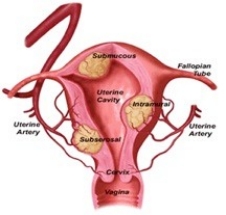Adenomyosis
Adenomyosis may be defined as the benign invasion of endometrium into the myometrium, producing a diffusely enlarged uterus.
The incidence of Adenomyosis is under discussion since different imaging criteria are used. Kunz et al, found a prevalence of adenomyosis in 70% of women with endometriosis, compared with 9% in healthy controls Using MRI, De Souza et al. detected discrete and diffuse patterns of Adenomyosis in 54% of young women with infertility and dysmenorrhoea or menorrhagia. In a recently published study in the US,, investigators tried to identify, in hysterectomized women undergoing the menopausal transition, possible symptoms specific for adenomyosis.. Adenomyosis was found in 48% of 137 patients and, in these women.
Adenomyosis has two main symptoms: lengthened menstrual periods, which, as the disease progresses, may be replaced by a continuous hemorrhagic discharge; and a great deal of pain
Today it is widely accepted that the only two practical ways to reach a valid diagnosis are transvaginal sonography (TVS) and MRI
There are several treatment alternatives for Adenomyosis:
Uterine Artery Embolization
Several reports, mostly from the Far East, suggest that UAE is an effective therapy for adenomyosis.
In 2001, Siskin et al. retrospectively evaluated the MRI appearance and clinical response of patients undergoing uterine artery embolization (UAE) for the treatment of menorrhagia due to adenomyosis. Of the 15 patients in the study, five had diffuse adenomyosis without evidence of Uterine Fibroids, one had focal adenomyosis without evidence of uterine fibroids and the remaining nine had adenomyosis with one or more fibroids. At 12 months follow-up, 92.3% patients reported significant improvement in symptomatology and quality of life.

Signs and Symptoms of Adenomyosis
Some women with adenomyosis do not experience any symptoms, while others may have severe, debilitating symptoms.
Some of the symptoms are:
• Intense debilitating pain all the time and/or
• Acute & increasing pain at menstruation and ovulation
• Strong ‘contraction’ feel of uterus
• Abdominal cramps
• A ‘bearing’ down feeling
• Pressure on bladder
• Dragging sensation down thighs and legs
• Heavy bleeding and flooding
• Large blood clots
• Prolonged bleeding i.e.; up to 8–14 days


